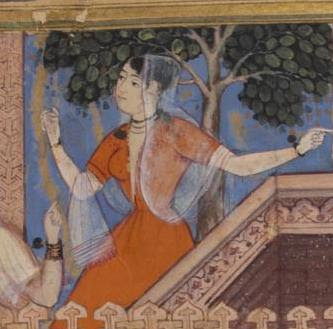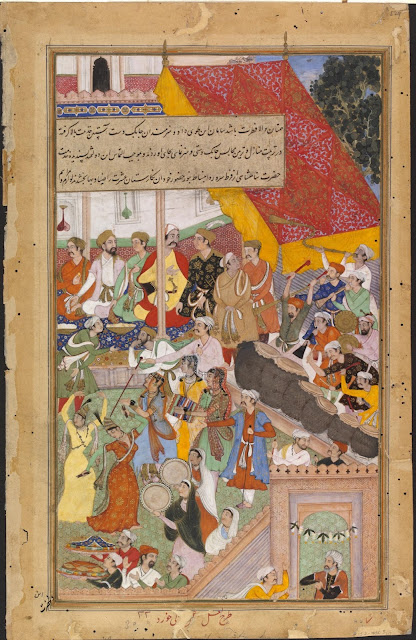I've been digging through the fine collection that the Victoria and Albert Museum has put online of Mughal works, most from the Akbarnama and Baburnama. An overwhelming number of these illuminations feature men fighting, men negotiating, and men relaxing together. Finding women in the illuminations is a bit harder. But it can be done.
This morning, I found Mariam Makani in this image.
This illumination by Tulsi and Dursa is believed to be from around 1586-1589. From the interpretation:
This painting from the official history of Akbar's reign depicts his mother, Mariam Makani, travelling to Agra by river. It is related to IS.2:3-1896 which shows several boats including that of the emperor, and was painted by Tulsi and Durga.
The Akbarnama (Book of Akbar) was commissioned by the emperor Akbar as the official chronicle of his reign. It was written by his court historian and biographer Abu'l Fazl between 1590 and 1596 and is thought to have been illustrated between c. 1592 and 1594 by at least forty-nine different artists from Akbar's studio. After Akbar's death in 1605, the manuscript remained in the library of his son, Jahangir (r. 1605-1627) and later Shah Jahan (r. 1628-1658). The Victoria and Albert Museum purchased it in 1896 from Mrs. Frances Clarke, the widow of Major General Clarke, an official who had been the Commissioner in Oudh province between 1858 and 1862.
Mariam appears to be wearing both a shawl and a veil, but no apparent hat.
It's pretty hard to see what else she is wearing, thought it is certain the outfit covers most of her. I suspect this is a one piece full body dress. She appears to be of advanced age. She also appears to be wearing some form of jewelry in the form of necklaces.
Overall, as an illuminator, I am fascinated by the tiny depictions of patterns in the cloth behind her - yet thre doesn't appear to be any pattern in the dress she is wearing.
Another image, this one unaccredited and with little interpretation, shows two women.
The lady on the left appears to be wearing a coat of some sort over a full length chemise or gown. It does appear to have closures. But is she wearing one lined coat or two separate coats? I'm thinking separate, since the long right sleeve is the dark, patterned blue that appears to also be a lining at the opening. But the hems... hm. Maybe it's a particolor coat.
The hairstyles, though. These women are wearing their hair uncovered. Interesting.
The museum only says this image dates back to the late 16th century.
Here's the link.
Another unknown late 16th century manuscript, and this one really changes a few perspectives for me.
This has my attention. The interpretation:
Painting, in opaque watercolour on paper, Khujista, the merchant's wife, talking to the parrot. Illustration to the story of the 11th evening from a manuscript of the Tuti-nama, 'Tales of a Parrot', by Ziya al-din Nakhshabi.
Holy fish, what is she wearing?
There's a LOT to take in here. She appears to be wearing a very sheer dupatta over a jeweled headpiece, earrings and so many necklaces, wristlets and arm bands - which, just by the term "wife," she has the rights to wear (widowed women don't wear much adornment). But I'm noting several things here.
1. Her hair, while dressed in jewels, also appears to be at least knee length.
2. She appears to be wearing an overtunic of some sort instead of a coat. It's mid-bicep length, and probably about mid-thigh as well. I've read descriptions of undergarments of similar length, but so far hadn't encountered an overgarment. That being said, it also might be tightly closed, as noted with those two lines between her breasts to the waist.
3. I can't tell if she is wearing pants or a chemise, but if they are pants they are quite baggy.
I could totally do this.
Next image, from Lahore, Pakistan - which means it would likely have both Mughal and Persian influences. It has ALL the LITTLE HATS.
And, honestly, this artist seemed to love the boobs.
This one is credited as possibly Pakistani AND Mughal. The interpretation:
This drawing relates closely to a fully coloured painting in a copy of Nezami's Khamsa now in the British Library and done for the Mughal emperor Akbar in 1004 AH/1595-6. It depicts Shirin entertaining Khusraw in a garden pavilion, accompanied by female attendants who play music and pour wine. Two others stand behind the couple holding a sword wrapped in cloth and a sash, both emblems of royalty. The features of Khusraw resemble those of the emperor as seen in contemporary paintings.
So, I'm seeing some definite handkerchief-style bottoms here...
This chick has all sorts of action going on (outside of those strangely perkified breasts, which I'm not certain would really occur that way in nature). The cross-over and bottom of the outfit do appear to resemble the bottom of the dels Grav has been constructing.
It's as if these front pieces are intentionally triangular/trapezoidal or there are additional gore pieces added, which backs up the gored but open flaps Grav has been using on the dels.
But the coats (or dels) are also longer.
There's also the hat, which is more Persian than Mughal (note the little peaked top). I'd love to have a hat like this, which hugs the head tight.
She's also wearing pants. And a thin sash that wraps around and then dangles from the waist.
But look in the lower right corner.
Unlike other examples of this hat, the veil here appears to be pinned to the hat's back, or bottom, edge. There's also a definitive lip. Is this a stiff hat? Unfortunately, not being able to see the bottom of her garment, it's almost impossible to tell if she's wearing a simple long coat or layers of coats.
But that is DEFINITELY a keyhole neckline. I'm planning to convert the tight necks of each of my current underdresses to keyholes for comfort.
It's a brush drawing on paper. The interpretation:
Drawing, in ink and opaque watercolour on paper, a monochrome brush drawing in black and grey tones (slightly tinted in places), copied, in adapted form, from an Italian late 16th century or early 17th century drawing or print of the type distributed by the Jesuit missionaries in India and Persia at that period. Depicting a lady of high rank (possibly St. Catherine of Alexandria) with preceptors; seated in discussion, with other male and female figures in costumes suggesting Indianised Elizabethan garments.
WHAT?
Hot diggety daffodil. This piece has ALL THE WINS.
It's a depiction of Elizabethan clothing as Indian daily wear.
This chick.
What is going on with her? Here's this ornate headband and jeweled waistband, some sort of pinned up over and underdress or coat and bare feet...
And this chick...
She seems to be wearing something comparable, but it doesn't really look like anything Persian, Mughal OR Italian. It looks like some sort of cross between I Dream of Jeannie and a coat-and-tails, made of pajama silk. I can't even.
This chick
is like "leave me alone and let me read my book already."
And this guy...
is SAUCY. Though what he's wearing? I don't even.
All right, another one,
a prince and a lady.
This is different! She's totally handkerchiefing that bottom edge there.
There is so much going on here. Her duppatta or veil is colored silk, possibly patterned. She has short sleeves but they're part of the overdress. She's wearing pants AND SHOES. Lots of jewelry.
Those points, though. DAMN. What IS that?
Also, his coat is crossed like a del but flares like a Persian coat. I need more information.
So, here's another piece commissioned by Akbar.
And the interpretation:
The Hamzanama, or Book of Hamza, was commissioned by the great Mughal emperor Akbar (r.1556–1605) in the mid 16th century. It is based very loosely on the life of the uncle of the Prophet Muhammad. The epic story chronicles the fantastic adventures of Hamza as he and his band of heroes fight against the enemies of Islam and against monsters, demons, dragons and sorcerers. The tales, from a long-established oral tradition, were written down by calligraphers in Persian, the language of the court, in multiple volumes. These originally had 1400 illustrations, of which fewer than 200 survive today. Work probably began in about 1562 and took 15 years to complete.
This scene, set in a rocky landscape, has not been conclusively identified. A king, distinguished by the feather aigrette in his turban, grasps a demoness by the hair and raises his sword to behead her. His companions stay behind the rocks, making conventional gestures of amazement. The blue sky is filled with stylised clouds typical of Chinese decoration and derived from Iranian painting.
Okay, so a demoness might not look like other women, but I am guessing there are costume clues here. The bit one is hey, there's a bold pattern on that dress.
There's a LOT of detail here. The dress appears to either have a pleated waistband or that's a very, very thin belt. It's a single, shortsleeved shift with what appears to be a plain underdress. And she's wearing a shawl or veil around her shoulders. Also, she has hips like me. A whole lot of the Mughlai women are depicted with these big hips. Makes me feel at home in the clothing.
Okay, another...
here's a wedding.
The interpretation:
In this illustration to the Akbarnama by La'l and Banwali Khord, musicians and dancers perform for the celebration of the marriage of Maham Anaga's son. Maham Anaga was the foster-mother of the emperor Akbar and was a powerful figure in the court. The painting is half of a double page composition, the related page (IS.2:9-1896) showing Maham Anaga sitting next to Akbar in the royal pavilion.
The dancers. The musicians. This is a full-blown party going on right here.
All in one image - women in conical hats, women in hair jewelry and translucent but colored veils, women in shawls. Short sleeves. Long sleeves. Patterns. Whatever that cross-your-heart number is on the chick in yellow. Here, right here, is a nice display of all sorts of attire at one point.
And, as far as I can tell, no coats.
Also, this guy.
Whatever epic story is being told here.
And epic handlebar moustache dude. What is he doing? And why is it pleasing that other fellow so much?
The patterning is exquisite.
The other side:
The interpretation.
This is part of a double-page illustration from the Akbarnama (Book of Akbar). It depicts the marriage festivities of the son of Maham Anaga, the foster-mother of the Mughal emperor Akbar (r.1556–1605). Maham Anaga held a powerful position at court, as shown by her dominant position in the painting, sitting next to Akbar. An accompanying painting, Museum no. IS.2:8-1896, illustrates dancers and musicians performing in the celebrations. The Mughal court artist La’l was responsible for the design of the two-page composition, with Sanwala painting the details of this half.
A closeup of Maham Anaga.
Except for the shape of her head and her reversed position, not that much different from Mariam Makani in the boat. Maham has a little bit of a belly going on there, too. Necklaces and small bracelets but no other jewelry. A single shift with a veil or two.
Also, these coats
are freaking incredible and I want them both. Look at that patterning on the right. Look at that design on the left.
And then look at what appears to be a blue del at first, but then seems to be more of a foldover robe, on the dude on the right.
What have we here?
What IS that? Can I have one?



































